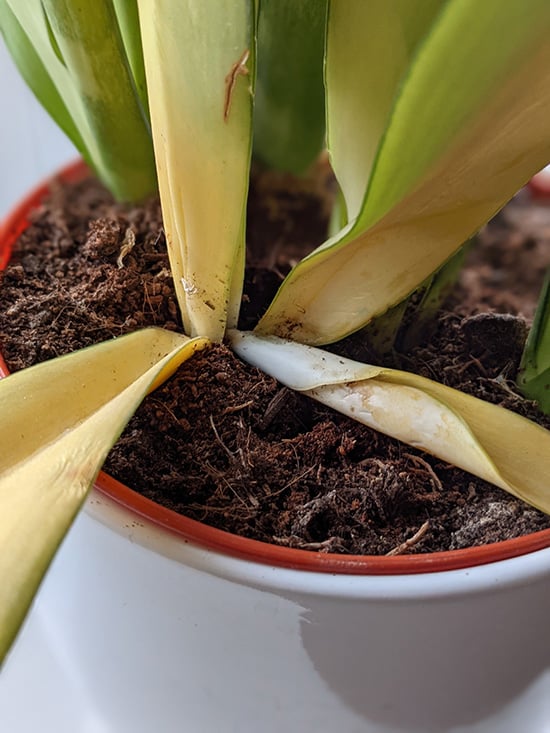The Buzz on Snake Plant Leaves Turning Yellow
Wiki Article
Examine This Report on Snake Plant Leaves Turning Yellow
Table of ContentsSnake Plant Leaves Turning Yellow Fundamentals ExplainedSome Ideas on Snake Plant Leaves Turning Yellow You Need To KnowSome Known Facts About Snake Plant Leaves Turning Yellow.Getting My Snake Plant Leaves Turning Yellow To WorkThe Main Principles Of Snake Plant Leaves Turning Yellow Get This Report on Snake Plant Leaves Turning Yellow
Below are 7 reasons your snake plant's leaves can be transforming yellow and just how to repair it. A number of different plant issues can cause yellow leaves, or chlorosis. Chlorosis happens when plants don't have the micronutrients they need to create chlorophyll, which makes foliage environment-friendly and enables plants to convert sunshine into food.Serpent plants are drought forgiving thanks to their delicious fallen leaves (Snake Plant Leaves Turning Yellow). These plants grow ideal in loosened, well-drained dirt that's enabled to dry out entirely between waterings and may only require water once each month during winter months. Overwatering can protect against roots from soaking up dampness and nutrients that the plant needs and can even create origin rot
A potbound plant can not absorb nutrients from the dirt. If your snake plant is overcrowded or outgrowing its pot, this might be the source of yellow fallen leaves. A periodic yellow leaf is entirely normal for a snake plant. As the plant ages, old fallen leaves yellow, die, and leave as they're changed with brand-new ones.
The Single Strategy To Use For Snake Plant Leaves Turning Yellow

If the leaves on your serpent plant are obtaining soft, it's usually a sign of way too much water. Serpent plants store water in their fallen leaves and if they're overwatered, the leaves can become soft and mushy. If you believe your serpent plant is being overwatered, enable the soil to dry out totally before watering once again.
Yes, some yellowing is regular and to be anticipated on older leaves, particularly as snake plants age. If the plant is or else healthy and the fallen leaves are only lightly yellowed then there is no reason for issue. If the leaves are dramatically yellowed or if there are other indications of distress after that it's ideal to take activity.
Some Known Details About Snake Plant Leaves Turning Yellow

In basic, serpent plants should be have a peek at these guys watered every one to 2 weeks. If you believe your snake plant has actually been overwatered, the first step is to quit sprinkling it.
With a little examination, you should have the ability to identify the reason blog and take steps to take care of the problem and have a healthy and balanced serpent plant. - Snake Plant Leaves Turning Yellow
Snake Plant Leaves Turning Yellow for Beginners
The snake plant is an amazing houseplant. The serpent plant is one of those plants that are wonderful for growing inside your home in a terrarium, Serpent plants can expand quite huge, yet they also tend to be pretty low-maintenance.When the soil is overwatered, the plant cells soak up more water than they can store. Read right here to Leaves come to be soggy and yellow as they take in extra water. Sagging serpent plant fallen leaves are caused by soaked-up leaf cells shedding their firmness. You may notice that your snake plant will become black or brown if the yellow spots are not dealt with by remedying overwatering.
It is, consequently, extra most likely that your plant will identify yellow spots on its leaves if you overfeed it with plant food throughout winter season. The fallen leaves of serpent plants are additionally at risk to yellowing when overfed, particularly if the roots are delicate. Repotting your yellowing, sprinkling only when the dirt dries out, and giving ideal temperature level and light problems can wait.
Facts About Snake Plant Leaves Turning Yellow Revealed
To quit yellowing triggered by overwatering, stop watering the serpent plant until the soil entirely dries out. Water your serpent plant only when the top 2 inches of soil feel completely dry.Your can be eliminated by removing the yellow suggestions. The trimmed leaves should expand longer if they are watered effectively and have optimum light and temperature conditions. It is vital to remember that the sharp suggestions will certainly not regrow, triggering them to attract attention from the rest of the leaves.
you could try this out It will not take long for the fallen leaves to grow back and grow like the healthy and balanced leaves around them. At the same time, you can get rid of damaged fallen leaves from the base of the plant. The shows that it's getting excessive or insufficient light or nutrients. The vital message is to enable the serpent plant time to recuperate.
The Of Snake Plant Leaves Turning Yellow
Scroll the write-up till the end to discover the solution. Pay attention to this short article here: The situation can be expected if you have actually had your snake plant for a very long time, and yellowing happens on the reduced leaves as an all-natural aging cycle. Also, it is common for the Sansevieria delegates transform yellow due to beginner errors and when the plant is just purchased from the nursery for repotting.Several of the most usual reasons are provided below. Sansevierias like dry climates and like little water preserved at a space of as soon as or twice once a week in summer and month-to-month in winter months. Yet when the water dose leaves control, your Sansevieria will suffer from overwatering. The most usual issue released by overwatering is root rot causing mushy origins and stems with a nasty smell.
Report this wiki page